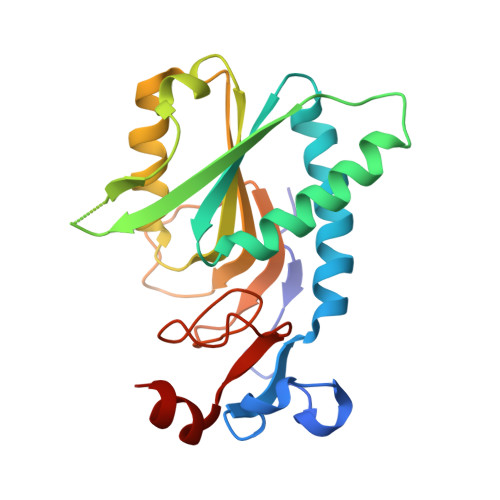Synthesis and Evaluation of Asymmetric Acyclic Nucleoside Bisphosphonates as Inhibitors of Plasmodium falciparum and Human Hypoxanthine-Guanine-(Xanthine) Phosphoribosyltransferase.
Spacek, P., Keough, D.T., Chavchich, M., Dracinsky, M., Janeba, Z., Naesens, L., Edstein, M.D., Guddat, L.W., Hockova, D.(2017) J Med Chem 60: 7539-7554
- PubMed: 28813147
- DOI: https://doi.org/10.1021/acs.jmedchem.7b00926
- Primary Citation of Related Structures:
5W8V - PubMed Abstract:
Acyclic nucleoside bisphosphonates (ANbPs) have previously been shown to be good inhibitors of human hypoxanthine-guanine phosphoribosyltransferase (HGPRT) and Plasmodium falciparum (Pf) hypoxanthine-guanine-xanthine phosphoribosyltransferase (PfHGXPRT). On the basis of this scaffold, a new series of ANbPs was synthesized. One of these new ANbPs, [3-(guanine-9-yl)-2-((2-phosphonoethoxy)methyl)propoxy]methylphosphonic acid, exhibited K i values of 6 and 70 nM for human HGPRT and Pf HGXPRT, respectively. These low K i values were achieved by inserting an extra carbon atom in the linker connecting the N 9 atom of guanine to one of the phosphonate groups. The crystal structure of this ANbP in complex with human HGPRT was determined at 2.0 Å resolution and shows that it fills three key pockets in the active site. The most potent phosphoramidate prodrugs of these compounds have IC 50 values in the low micromolar range in Pf lines and low toxicity in human A549 cells, demonstrating that these ANbPs are excellent antimalarial drug leads.
Organizational Affiliation:
The Institute of Organic Chemistry and Biochemistry of the Czech Academy of Sciences , Flemingovo nám. 2, CZ-16610 Prague 6, Czech Republic.
















